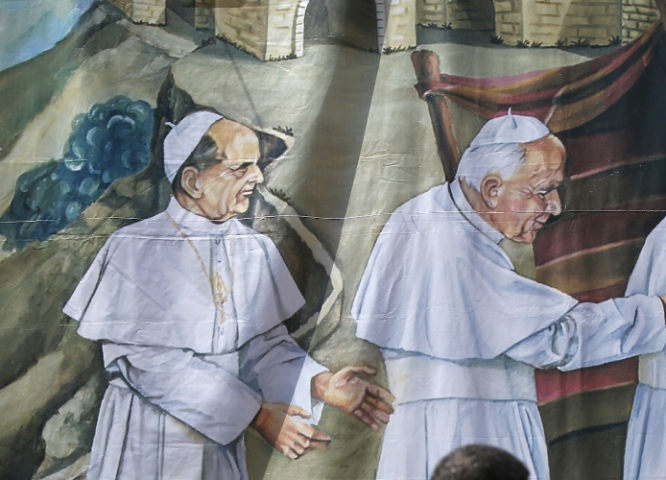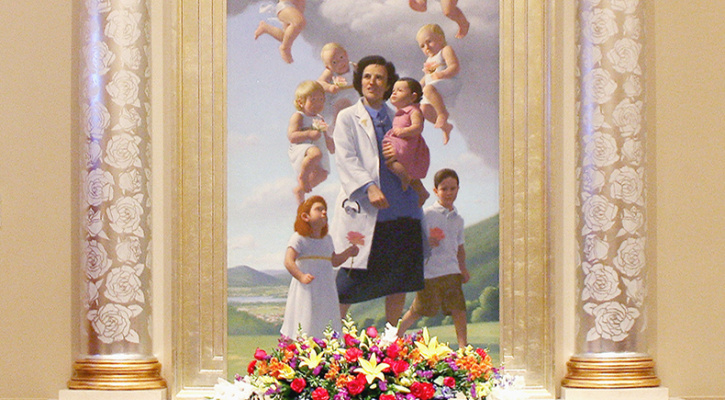In Veritatis Splendor, John Paul II gave an uncompromising defence of Humanae Vitae
By Fr Raymond de Souza, Catholic Herald, Thursday, 9 Aug 2018
August 6th is probably the most common date of secular significance put to homiletic use. Preachers for that day’s feast of the Transfiguration are apt to compare the light of Christ, which transfigures unto glory, with the light seen in Hiroshima on 6th August 1945, when for the first time came that light which disfigures unto death.
August 6th this year united two other anniversaries of import in recent Catholic history: the death of Blessed Paul VI in 1978, and the publication of Veritatis Splendor by St John Paul II in 1993. Veritatis Splendor marked the half-way point between Humanae Vitae (1968) and today, and so provides a reference point for the ministry of the Roman pontiff over these last 50 years.
By 1978, Blessed Paul VI had long borne the heat of the day; he was weary of being the helmsman of a Church in stormy waters. On the feast of Saints Peter and Paul he celebrated the 15th anniversary of his pontificate and he saw failure around him on every side. The Church was wounded and weak, and the great promise of the Second Vatican Council lay in tatters. But the Holy Father could confess with a clear conscience that he had not betrayed the truth.
“This the Church’s faith, the apostolic faith,” Paul preached for his anniversary, six weeks before he died. “The teaching is preserved intact in the Church through the presence within her of the Holy Spirit, and through the special mission entrusted to Peter, for whom Christ prayed … Such is the untiring, watchful and consuming purpose that has carried us forward during these 15 years of our Pontificate. ‘I have kept the faith!’ we can say today, with the humble but firm consciousness of never having betrayed ‘the holy truth’.”
In 1978, it was an open question whether any pope might be able to teach the truth clearly – especially on moral matters – and get a hearing in the Church, let alone the world. That the pope could be a lonely, beleaguered, heroic voice had been demonstrated by Paul VI, but was that the best that could be achieved? Perhaps so, and the Holy Father would have to pay a heavy price for it.
“The commitment to teaching in the service and defence of truth, which we have offered at the cost of much suffering, includes we believe, as an indispensable part, the defence of human life,” Paul said in that final homily. “The defence of human life must begin at the very source of human existence … We did no more than accept this charge when, ten years ago, we published the encyclical Humanae Vitae … We have made these statements, motivated only by our supreme responsibilities as universal teacher and pastor, and for the good of humanity.”
Fifteen years after the death of Paul VI, John Paul would attempt the most controverted moral teaching since Humanae Vitae twenty-five years earlier. In Veritatis Splendor, John Paul presented the Church’s teaching about the moral vocation to beatitude as a whole, rather than on any particular question. John Paul was well aware of the crisis that Paul VI lamented at the end of his pontificate. He sought to imitate his predecessor’s 15th anniversary boast that he had not betrayed the truth, and gave a fulsome exposition of the whole of moral truth on his own 15th anniversary in 1993.
Veritatis Splendor rejected at length the objections that Paul VI faced in his time, namely that in teaching the truth about the moral law, the Church was lacking in compassion and in respect for freedom.
“Genuine understanding and compassion must mean love for the person, for his true good, for his authentic freedom,” wrote John Paul in Veritatis Splendor. “And this does not result, certainly, from concealing or weakening moral truth, but rather proposing it in its most profound meaning.”
It is possible to trace a twenty-five year arc from 1968, with its fierce dissent from Humanae Vitae, to 1978, and Paul VI’s lament against that dissent from his faithful teaching mission, to 1993, and Veritatis Splendor’s presentation of the necessity of moral truth for authentic human freedom.
Indeed, at the conclusion of the central chapter of Veritatis Splendor, which treats at length the Church’s teaching on permissible moral theories, John Paul goes back to quote Humanae Vitae that is “never lawful, even for the gravest reasons, to do evil that good may come of it”.
Veritatis Splendor, exactly 15 years after Paul VI’s death, was the response to the challenge that Paul VI issued as he went to his death. In the weeks ahead, I will be looking closely at the content of that response.
_______________________________







